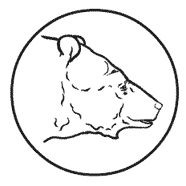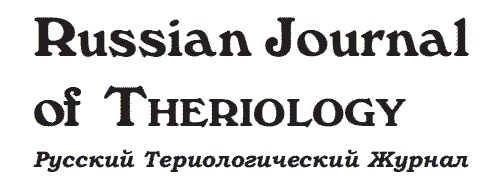New records on the distribution of the Kamchatka shrew (Sorex camtschaticus Yudin, 1972) in North-East Asia
Dokuchaev N.E.
P. 12-16
The northeastern limits of the Kamchatka shrew distribution were found to extend much further and include the northeastern territories of the Koryak upland. The new capture points indicate a shift in the range of the species to the east by 500 km from the previously known ones. A distance of only 130 km separates the nearest catching sites of the Kamchatka and Portenko’s shrews.
DOI: 10.15298/rusjtheriol.24.1.03References- Andreev A.V., Dokuchaev N.E., Krechmar A.V. & Chernyavsky F.B. 2006. [Terrestrial Vertebrates of North-East Russia: annotated catalog of species distribution and biology]. Magadan: NESC FEB RAS. 315 p. [in Russian].
- Anisimov V.D. & Dolgov V.A. 1996. [Shrew fauna of the Arctic coast of Chukotka] // Moscow University Biological Sciences Bulletin. Ser.16. No.1. P.34–38 [in Russian].
- Bannikova A.A., Chernetskaya D., Raspopova A., Alexandrov D., Fang Y., Dokuchaev N., Sheftel B. & Lebedev V. 2018. Evolutionary history of the genus Sorex (Soricidae, Eulipotyphla) as inferred from multigene data // Zoologica Scripta. Vol.47. No.5. P.518–538.
- Chernyavsky F.B. 1984. [Mammals of the extreme north-east of Siberia]. Moscow: Nauka. 389 p. [in Russian].
- Demboski J.R. & Cook J.A. 2003. Phylogenetic diversification within the Sorex cinereus group (Soricidae) // Journal of Mammalogy. Vol.84. No.1. P.144–158.
- Dokuchaev N.E. 1990. [Ecology of Shrews in North-East Asia]. Moscow: Nauka. 160 p. [in Russian].
- Dokuchaev N.E. 1994. [Structure and productivity of the shrew communities (Insectivora, Soricidae) on Chukot Peninsula] // Zoologicheskii Zhurnal. Vol.73. No.9. P.114–123 [in Russian].
- Dokuchaev N.E. 1997. [The role of Beringia in migration and speciation of shrews // Vestnik of the Far East Branch of the Russian Academy of Sciences. No.2. P.54–61 [in Russian].
- Dokuchaev N.E. 1999. [Biogeography and taxonomic diversity of shrews in North-East Asia] // Doklady Akademii Nauk. Vol.364. No.3. P.420–422 [in Russian].
- Dokuchaev N.E. 2019. [Kamchatka shrew] // [Red Data Book of the Magadan Oblast. Rare and Endangered Species of Animals, Plants, and Fungi)]. Magadan: Okhotnik. P.135 [in Russian].
- Dolgov V.A. & Krivoscheyev V.G. 1973. [On the fauna of shrews (Mammalia, Sorex) of Chukotka] // Biological Problems of the North. No.2. Magadan: Far East Scientific Centre of Academy of Sciences of USSR. P.74–76 [in Russian].
- Dolgov V.A. & Reymers N.F. 1979. [Shrews (Sorex) of Kamchatka (Mammalia, Soricidae)] // Proceedings of the Zoological Museum of Moscow State University. Vol.18. P.264–273 [in Russian].
- Dolgov V.A. 1985. [Shrews of the Old World]. Moscow: Moscow University Press. 221 p. [in Russian].
- Findley J.S. 1955. Speciation of the wandering shrew. University of Kansas Publications, Museum of Natural History. Vol.9. No.1. P.1–68.
- Fumagalli L., Taberlet P., Stewart D.T., Gielly L., Hausser J., & Vogel P. 1999. Molecular phylogeny and evolution of Sorex shrews (Soridae: Insectivora) inferred from mitochondrial DNA sequence data // Molecular Phylogenetics and Evolution. Vol.11. No.2. P.222–235.
- George S.B. 1988. Systematics, historical biogeography and evolution of the genus Sorex // Journal of Mammalogy. Vol.69. No.3. P.443–461.
- Gromov I.M. & Baranova G.I. (eds). 1981. [Catalogue of Mammals of the USSR (Pliocene-modern)]. Leningrad: Nauka. 456 p. [in Russian].
- Hoffmann R.S. & Peterson R.S. 1967. Systematics and zoogeography of Sorex in the Bering Strait Area // Systematic Zoology. Vol.16. No.2. P.127–136.
- Ivanitskaya E.Yu. & Kozlovsky A.I. 1985. [Karyotypes of Palearctic shrews of the subgenus Otisorex with comments on taxonomy and phylogeny of the group «cinereus»] // Zoologicheskii Zhurnal. Vol.64. No.6. P.950–952 [in Russian].
- Lissovsky A.A., Sheftel B.I., Saveljev A.P., Ermakov O.A., Kozlov Yu.A., Smirnov D.G., Stakheev V.V. & Glazov D.M. 2019. [Mammals of Russia: species list and applied issues] // Archives of Zoological Museum of Moscow State University. Vol.56. Moscow: KMK Scientific Press. 191 p. [in Russian].
- Ohdachi S.D., Hasegawa M., Iwasa M.A., Vogel P., Oshida T., Lin L.K., & Abe H. 2006. Molecular phylogenetics of soricid shrews (Mammalia) based on mitochondrial cytochrome b gene sequences: with special reference to the Soricinae // Journal of Zoology. Vol.270. P.177–191.
- Okhotina M.V. 1977. Palearctic shrews of the subgenus Otisorex: biotopic preference, population number, taxonomic revision and distribution history // Acta Theriologica. Vol.22. No.11. P.191–206.
- Okhotina M.V. 1984. [Order Insectivora Bowdich, 1821] // Krivosheyev V.G. (ed.). [Terrestrial mammals of the Far East of the USSR: key]. Moscow: Nauka. P.31–72 [in Russian].
- Pavlinov I.Ya., Kruskop S.V., Varshavski A.A. & Borisenko A.V. 2002. [Terrestrial animals of Russia. Identification guide]. Moscow: KMK Scientific Press. 298 p. [in Russian].
- Stroganov S.U. 1956. [A new species of shrew from the Siberian fauna] // Proceedings of the Biological Institute. West Siberian Branch Academy of Sciences USSR. Issue Zoological. No.1. P.11–14 [in Russian].
- Stroganov S.U. 1957. [Animals of Siberia. Insectivores]. Moscow: Publishing house of the Academy of Sciences of the USSR. 267 p. [in Russian].
- van Zyll de Jong C.G., 1982. Relationships of amphiberingian shrews of the Sorex cinereus group // Canadian Journal of Zoology. Vol.60. P.1580–1587.
- van Zyll de Jong C.G., 1991. Speciation in the Sorex cinereus group // Findley J.S. & Yates T.L. (eds.). The biology of the Soricidae. Special Publication the Museum of Southwestern Biology. No.1. Albuquerque, New Mexico: Museum of Southwestern Biology. P.65–73.
- Yudin B.S. 1969. [Taxonomy of some species of shrews (Soricidae) from Palaearctic and Nearctic] // Acta Theriologica. Vol.14. No.3. P.21–34 [in Russian].
- Yudin B.S. 1971. [Insectivorous mammals of Siberia (Key)]. Novosibirsk: Nauka. 172 p. [in Russian].
- Yudin B.S. 1972. [Contribution to the taxonomy of the transarctic common shrew (Sorex cinereus Kerr, 1792) from the USSR fauna] // Theriology. Vol.1. Novosibirsk: Nauka. P.45–50 [in Russian].
- Yudin B.S. 1973. [On characteristic of the transarctic shrew (Sorex cinereus Kerr, 1792) from Northeast Siberia and Kamchatka] // Proceedings of the Biological Institute. No.16. Novosibirsk: Nauka. P.269–279 [in Russian].
- Yudin B.S. 1975. [Complexes of Insectivorous Mammals (Mammalia, Insectivora) of the Far East] // Proceedings of the Biological Institute. No.23. Novosibirsk: Nauka. P.41–69 [in Russian].
- Yudin B.S., Krivosheyev V.G. & Belyaev V.G. 1976. [Small Mammals of the North of the Far East]. Novosibirsk: Nauka. 270 p. [in Russian].
- Yudin B.S. 1989. [Insectivorous Mammals of Siberia]. Novosibirsk: Nauka. 360 p. [in Russian].
- Zaitsev M.V., Voyta L.L. & Sheftel B.I. 2014. [The mammals of Russia and adjacent territories. Lipotyphlans]. Saint Petersburg: Nauka. 391 p. (Key on fauna of Russia, published by the Zoological Institute of the Russian Academy of Sciences. Issue 178) [in Russian].
Download PDF
|

